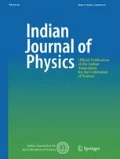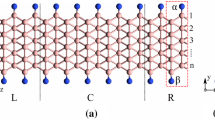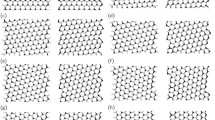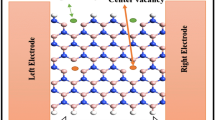Abstract
First-principles spin-polarized calculations have been performed on passivated boron-nitride nanoribbons (BNNRs) with pentagon–heptagon line-defects (PHLDs), also called as Stone–Wales line-defects. Two kinds of PHLDs, namely, even-line and odd-line PHLDs, have been added either at one edge or at both edges of BNNRs. Single-edge (with all its different possibilities, for example, for a BNNR with 2-line PHLD at single-edge there are eight possibilities) as well as both-edge passivations have been considered for all the ribbons in this study by passivating each edge atom with hydrogen atom. Density of states (DOS) and projected-DOS analysis have been accomplished to understand the underlying reason for various properties. We find that passivation lead to different effects on the electronic and magnetic properties of a system, and the effects are mainly based on the line-defect introduced and/or on the atoms which are present at the passivated edge. In general, we find that, passivation can play a key role in tuning the properties of a system only when it has a zigzag edge.





Similar content being viewed by others
References
S Dutta and S K Pati J. Mater. Chem. 20 8207 (2010)
L Lai et al. J. Phys. Chem. C113 2273 (2009)
F Zheng et al. Phys. Rev. B 78 205415 (2008)
V Barone and J E Peralta Nano Lett. 8 2210 (2008)
W Chen, Y Li, G Yu, Z Zhou and Z Chen J. Chem. Theory. Comput. 5 3088 (2009)
S S Yamijala and S K Pati J. Phys. Chem. C 117 3580 (2013)
E A Basheer, P Parida and S K Pati New. J. Phys. 13 053008 (2011)
E Kan, F Wu, H Xiang, J Yang and M-H Whangbo J. Phys. Chem. C 115 17252 (2011)
P Y Huang et al. Nature 469 389 (2011)
M Pan et al. Nano Lett. 12 1928 (2012)
H Zeng et al. Nano Lett. 10 5049 (2010)
R Mukherjee and S Bhowmick J. Chem. Theory. Comput. 7 720 (2011)
S Tang and S Zhang J. Phys. Chem. C 117 17309 (2013)
J M Soler et al. J. Phys. Condens. Matter. 14 2745 (2002)
P Ordejón, E Artacho and J M Soler Phys. Rev. B 53 R10441 (1996)
J P Perdew, K Burke and M Ernzerhof Phys. Rev. Lett. 77 3865 (1996)
K Burke, J P Perdew and M Ernzerhof Int. J. Quantum. Chem. 61 287 (1997)
N Troullier and J L Martins Phys. Rev. B 43 1993 (1991)
L Kleinman and D M Bylander Phys. Rev. Lett. 48 1425 (1982)
H J Monkhorst and J D Pack Phys. Rev. B 13 5188 (1976)
A Bandyopadhyay, S S R K C Yamijala and S K Pati Phys. Chem. Chem. Phys. 15 13881 (2013)
G Periyasamy, E Durgun, J-Y Raty and F Remacle J. Phys. Chem. C 114 15941 (2010)
P Tang, X Zou, S Wang, J Wu, H Liu and W Duan RSC Adv. 2 6192 (2012)
Acknowledgments
We thank TUE-CMS, JNCASR for providing the computational facilities. SKP thanks DST, India for funding.
Author information
Authors and Affiliations
Corresponding author
Electronic supplementary material
Below is the link to the electronic supplementary material.
Rights and permissions
About this article
Cite this article
Yamijala, S.S.R.K.C., Pati, S.K. Effects of edge passivations on the electronic and magnetic properties of zigzag boron-nitride nanoribbons with even and odd-line stone–wales (5–7 pair) defects. Indian J Phys 88, 931–938 (2014). https://doi.org/10.1007/s12648-014-0484-8
Received:
Accepted:
Published:
Issue Date:
DOI: https://doi.org/10.1007/s12648-014-0484-8




